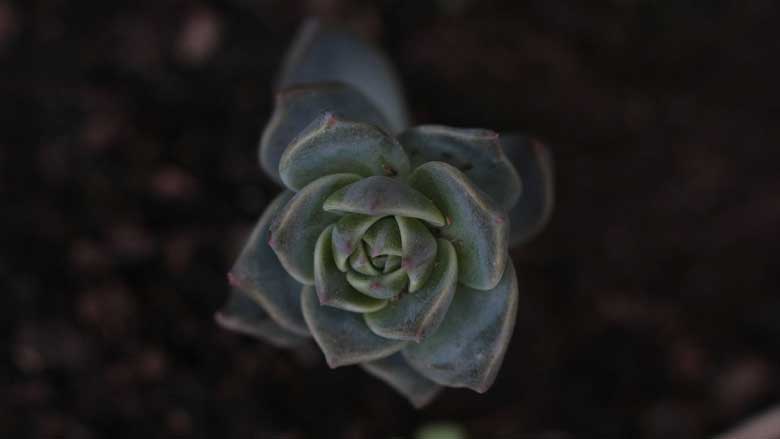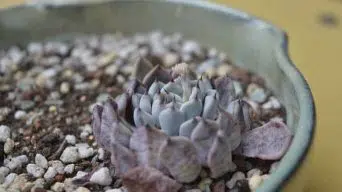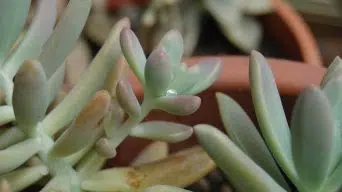Succulents are popular plants for gardeners because they require little water and can survive in most climates.
However, succulent care is not as simple as it seems. It’s easy to overwater succulents, which leads to root rot or other issues that can be difficult to identify early on.
This article will teach you how to identify the signs of an overwatered succulent.
Additionally, this article will show you how to treat an overwatered plant and prevent future occurrences from happening again!
What Are the Risks of Overwatering Succulent Plants
Overwatered and underwatered succulents can both be signs of poor care.
However, overwatering is the most common mistake made by succulent owners and growers.
An overwatered succulent is typically due to watering it too often, or the soil staying wet for too long.
This can lead to root rot and other fungal diseases that may ultimately kill succulents if not corrected soon enough.
An overwatered succulent is not only unsightly, but it can also cause severe problems for the health of your succulent.
Overwatered succulents cannot correctly absorb water or take in nutrients through their roots. This will lead to root rot and nutrient deficiencies which are very difficult, if not impossible, to treat.
An overwatered succulent is under too much water stress and may die.
The main problems with overwatering succulents are root rot, fungal diseases, nutrient deficiencies, and pest infestations.
Root Rot
Root rot is a common problem with succulents watered too often or kept in wet conditions for too long.
The soil stays soggy because your plant’s roots absorb water faster than they can drain it through the bottom of the pot. As such, fungi and bacteria can quickly grow in wet soil and cause succulent root rot.
Since this is a fungal disease, not much will happen until it completely takes over your plant.
At that point, you may notice discoloration of the leaves or low growth rates due to insufficient nutrients from the decomposing roots.
If overwatered succulents have been left too long without proper care, they should be thrown out since there’s no way to save them at that point.
Fungal Diseases
Fusarium and pythium are the most common fungus associated with succulent plants.
Fusarium species prefer slightly acidic conditions, while Pythium prefers higher pH values.
Both of these fungi are capable of causing root rot in succulents. Still, they also have other effects you may notice before the plant starts to suffer from rotting roots.
Affected leaves will develop yellow or brown spots, which later turn into holes as the fungus spreads throughout the rest of your succulent tissues.
The bottom line is that if you see any signs of fungal diseases on your plants, you should remove them immediately. There is no way to save succulents once fungi spread their spores around.
Nutrient Deficiencies
One of the most common signs that you’re overwatering your succulents is if their leaves become yellow or pale.
This happens because waterlogged roots cannot get enough oxygen and nutrients, causing them to die off – affecting the rest of the plant’s tissues since they become unbalanced.
Mild nutrient deficiencies can be treated by repotting your plants into new soil. They will have better drainage and airflow around their roots, so they don’t stay soggy for too long.
Some fertilizers may also help improve growth rates in these cases. But more severely affected specimens should be discarded unless all other factors (like root rot) are ruled out first.
Pest Infestation
The most common pests found among overwatered succulents are mealybugs and scale insects.
These sap-sucking intruders aren’t usually very harmful but multiply quickly and can spread plant diseases if not treated.
Mealybugs are small, white insects that live in colonies and will cover your succulent leaves with sticky honeydew excretion.
Scale insects look like bumps on the succulent surface and may also secrete honeydew when feeding off sap from under their shell.
Both types of pests should be removed by hand using cotton swabs dipped into alcohol or soapy water to kill them before they cause any further damage to your succulents.
How Does Overwatering a Succulent Occur
Overwatering is a common mistake that most people make when caring for succulents.
Succulent plants and cacti are desert-dwelling, requiring less water than other types of houseplants or vegetation outside in the garden.
They will not thrive if overwatered because their root systems cannot quickly process large quantities of water enough to survive.
An overwatered succulent plant is likely if the soil becomes saturated with water and can no longer absorb more, particularly with indoor container-grown succulents.
The excess water pools at the bottom of the container and leeches back into the roots through capillary action that pulls it upwards to all parts of the plant’s root system.
If this frequently occurs enough over time, your houseplant may begin to show signs of rot or mold issues because its cellular structure cannot function properly due to constant wetness.
Some common reasons why a succulent may be overwatered include the following:
- The succulents are watered too frequently.
- The potting soil mix is not draining correctly, and the plant’s roots become waterlogged.
- A humidity tray has been placed underneath the pot holding the soil mix, causing it to stay wet for longer than usual.
- The succulent is in a container without drainage holes, and the excess water pools at its base.
- The succulent was left to sit in water, and the roots absorbed so much of it that they began to rot.
- The succulent’s leaves are constantly wet due to being placed in an area with a lot of condensation.
- The room where the succulent is located has very high humidity levels, or it’s placed too close to an air vent that constantly blows hot air.
- The succulent has been placed in a container that’s too small for it, causing its root system not to have enough space to spread out and function properly.
How To Tell if You Are Overwatering Your Succulents
It is essential to be able to identify an overwatered succulent. If you do not, it will lead to a dead plant, and not knowing what happened is the worst part.
There are several symptoms to look for when you think your succulent is overwatered.
It may be difficult to tell if the succulent is overwatered initially, but checking for these signs will make it easier.
Signs of Overwatered Succulents
Several symptoms can identify an overwatered succulent.
Identifying an overwatered succulent immediately if you continue to water them is essential. At the same time, if they are in this condition, it will lead to more severe problems.
The symptoms of overwatering are:
Succulent Leaves Falling Off and Turning Yellow
Succulent leaves falling off and turning yellow is one of the first signs that you have an overwatered succulent.
When a succulent is overwatered, the waterlogged roots cannot deliver nutrients to the leaves.
The leaves will then begin to turn yellow and fall off the plant.
If your succulent leaves are falling off or turning yellow, you should check the root system to see if it is waterlogged.
Stem Turning Mushy
If your succulent has a mushy stem, then that means they have been sitting in too much moisture for an extended period.
This will lead to root rot and eventually death.
Succulent stem rot is a significant sign that your succulent needs immediate action because it will not get better on its own, only worse with time.
Plant Smelling Moldy
If the plant in question has been sitting for too long in the water, then there could be a chance of developing black or white mold on top of their soil, which can harm them if left untreated.
If the succulent plant smells musty when you lift some potting soil mix, mold is growing underneath.
To fix this problem, you must remove all excess moisture from the roots so they can no longer grow any more fungus under the surface.
Leaves Have Brown Tips
If the leaves at the very tips of your succulents are turning brown, it can indicate that there is too much salt in their soil.
Even if you water succulents regularly, this will happen because they take up most nutrients from a plant and do not allow for proper absorption of minerals.
If this problem happens, stop watering until all salts are removed to prevent further damage.
Leaves Are Limp and Squishy Instead of Firm or Rubbery
If you squeeze the leaves of an overwatered succulent, they should spring back into shape quickly.
If they are squishy or limp instead, then this is a sign that too much water is absorbed for them to bounce back properly.
This means it needs to be dried out completely before being watered again.
Roots Are Slimy or Rotten
If the roots are rotting, slimy, and smelly instead of dry, it is a significant sign that they have been sitting in water for too long.
If you see this type of problem, you need to stop watering immediately or your succulent plant will not recover from this condition.
Seeds Germinating Inside Soil
When seeds start sprouting inside the plant pot soil during winter, overwatering is usually an issue.
Even though most people do not realize this at first, all plants tend to slow down growth during colder months.
If you have been noticing your succulent seeds sprouting repeatedly, it is a sign that they are being overwatered.
Leaves Die Back to the Base
This is another indicator of overwatering because leaves do not tend to go from green on top to yellow underneath without there being an issue with their roots.
Several reasons, like bad soil or lack of sunlight, can cause this.
But if this symptom continues after correcting these problems, your plant needs more drainage holes at the bottom.
This will allow for proper airflow when watering so any excess moisture does not become trapped inside where rot begins.
White Spots on Leaves
If you notice white splotches of fungus growing on your succulents, this is another sign of too much moisture in the soil.
If left untreated, it can cause irreversible damage. Stop watering immediately until all soil moisture has dried up entirely before re-watering again.
Leaves Appear Dry and Wrinkly Even if They Are Watered Regularly
If succulents have some dry leaves but are still getting regular watering, this is because there might need to be more drainage holes at the bottom.
This can allow any extra liquid to flow out instead of sitting inside, where it will rot.
This causes them to wilt under the surface because their roots cannot absorb water properly when sitting in the soil for too long.
Leaves Are Brown and Dying
If you see that your succulent leaves are brown underneath, it is a sign that there are no drainage holes at the bottom. Proper drainage prevents excess moisture from rotting your succulent plant from below.
If you notice any signs, stop watering your plants until you add proper drainage. If you water the succulents without drainage, they may die from fungus or rot.
Leaves Grow Mold
Another issue happens when there are no drainage holes at the bottom, which causes water to sit inside for too long and creates a perfect environment for fungus or rot.
If you see any of these signs, stop watering until proper drainage has been added. Fungus or rot will make the plants die even if they are watered repeatedly.
How To Save an Overwatered Succulent
It is essential to act fast when you have an overwatered succulent. The sooner you save your plant, the better your chances of recovery are!
There are a few things you can do to save your plant:
Remove the Excess Water From the Container
You may use a spoon or a small piece of paper.
Be careful not to damage it further, though! If that is too late and leaves are turning yellow at their tips, cut them off completely – this will make room for new growth.
Place the Plant in a Bright and Dry Area
The best place to put your succulent plant is by a sunny window.
The sun will not only provide the necessary light, but it can also dry out the soil faster.
Prune Away Any Damaged Leaves or Stems
It is essential to do this as soon as possible.
If you leave them on, the plant will rot and die sooner than it should! You can also use your fingers or a pair of clippers for this task.
Do Not Water It for a Few Days, Maybe Even up to Two Weeks
You may check if the soil is moist or dry by gently touching the top of the soil visible on top of its pot.
If it feels damp and spongy, do not add more water. If dry, water your plant with tepid or room-temperature water.
Once the soil feels completely dried out and there are no visible signs of succulent rot on its leaves, roots, or stems – you can start watering again!
Make Sure To Use Well-Draining Succulent Mix Soil
Succulents require a particular type of soil that will allow excess water and oxygen flow.
This is necessary so the plant roots can easily access both if needed!
A succulent mix soil is recommended for these types of plants.
Replant It in a Larger Container
A succulent planted in too small of a pot will hold onto its roots for longer than necessary, causing it to rot and be unable to absorb water so easily!
When you replant your plant into the new fresh soil mix with proper drainage holes – try not to disturb or remove any of its old root systems.
Do Not Water Until the Soil Is Completely Dry
Succulents require minimal watering, so it is crucial never to overdo it!
Water your plant only when all of its soil has dried out. This will prevent any fungal infections and other types of rot that can affect a succulent’s health if left untreated for too long.
How To Prevent an Overwatered Succulent
There are several ways to prevent overwatering a succulent. The easiest method is understanding how often a succulent plant should be watered and how to water it correctly.
When dry, succulent plants need to be watered about an inch below their soil surface.
Succulents should be watered once every one to two weeks for most plants and more frequently if planted in a small pot or during warm summer temperatures.
When plants are dormant during winter, water succulents less frequently so the soil can dry out completely.
When watering succulents, thoroughly saturate all the soil immediately around the roots and allow excess moisture to drain from the bottom of the pot before re-watering.
Water slowly so it does not create puddles around your plant, which can cause root rot diseases.
Succulent plants need well-draining soils with coarse particles like sand, cactus mix, or crushed stone to help prevent overwatering your succulent by allowing excess water to drain through them quickly instead of pooling over long periods.
A healthy succulent plant requires good drainage, so using the appropriate pot for your plant’s size is essential.
You can plant succulents in decorative containers, but they need a good drainage system so excess water doesn’t pool around their roots and cause rot diseases.
Good drainage holes are key when planting succulent plants indoors or outdoors because it helps prevent overwatering and root rot.
Another way to prevent overwatering succulent plants is by placing them in an area with bright sunlight and more airflow.
Water evaporates quickly from the soil under hot, bright conditions, so plants do not stay wet enough to develop root rot diseases or other problems associated with overwatering succulent plants.
In short, you should water succulent plants once every one to two weeks. When watering, allow the soil around their roots to dry slightly between waterings.
Succulents require special attention when it comes to watering and drainage. The best way to prevent overwatering succulents is to provide them with the proper water and drainage.
Final Thoughts
Taking care of succulents is easy but requires a little bit of maintenance and knowledge to make sure they remain healthy.
Succulents require less water than other houseplants or vegetation outside the garden, so they should always be allowed to dry out in between waterings.
Overwatering is a common mistake that most people make when caring for succulents, and it is easy to avoid.
The best way to ensure that you’re watering your succulents correctly and enough, but not too much, is by sticking to a regular schedule for watering them.







